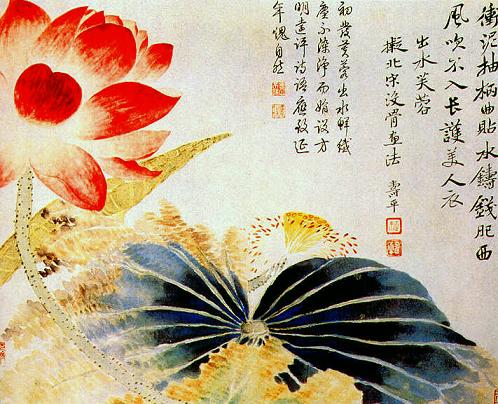
LIFE AS MYTH
![]()
JOURNAL
![]()
JOURNAL 2007
![]()
Following a white hart
Exploring myth & meaning
![]()
SUMMER 2007
Seeking the Ox
![]()
LIFEWORKS
![]()
ATLAS
![]()

SUMMER 2007
LOTUS MYTHOLOGY

A lotus breaking the surface. Yun Shouping. 17th century, Qing Dynasty. Palace Museum, Beijing.
As a symbol of rebirth, the lotus appears throughout world mythology. Its earliest mythic origins might be Egyptian where the lotus and the water lily are interchangeable icons for creation and rebirth -- but an eight-petalled flower, bearing a striking resemblance to later Buddhist depictions of the lotus, also shows up in the stone face of a 7000 year old passage tomb in Loughcrew, County Meath, Ireland. The lotus effect refers to the natural self-cleansing properties of the lotus plant. Though rooted in muddy and watery habitats, lotus are never wet or soiled. A drop of water on a lotus leaf or blossom will roll off, carrying dirt and debris with it.
The pink lotus is reserved for the highest deity and therefore associated with the Buddha.
The blue lotus, or utpala flower, is the lotus of Green Tara. Its possible meanings include: purity, infinite giving, refuge. Although the lotus is a fundamental element in Tibetan Buddhist iconography, the plant is not native to the region.
The white water lily has the unique feature of blossoming in moonlight, rather than in sunlight. The water lily and the lotus are sometimes interchangeable in mythological iconography. As the white lotus, this plant symbolizes the womb of creation. It is also the lotus of the Buddhas and the goddess White Tara.
The red lotus is associated with Avalokiteshvara, the bodhisattva of compassion. As such it is a symbol of all matters pertaining to the heart: love, passion, compassion.
In Hinduism, creation began with the first Aum. From the waters of nothingness, the Aum formed a lotus which shone like the sun. And this golden lotus emerged from the waters and from its heart all the universe came forth.
